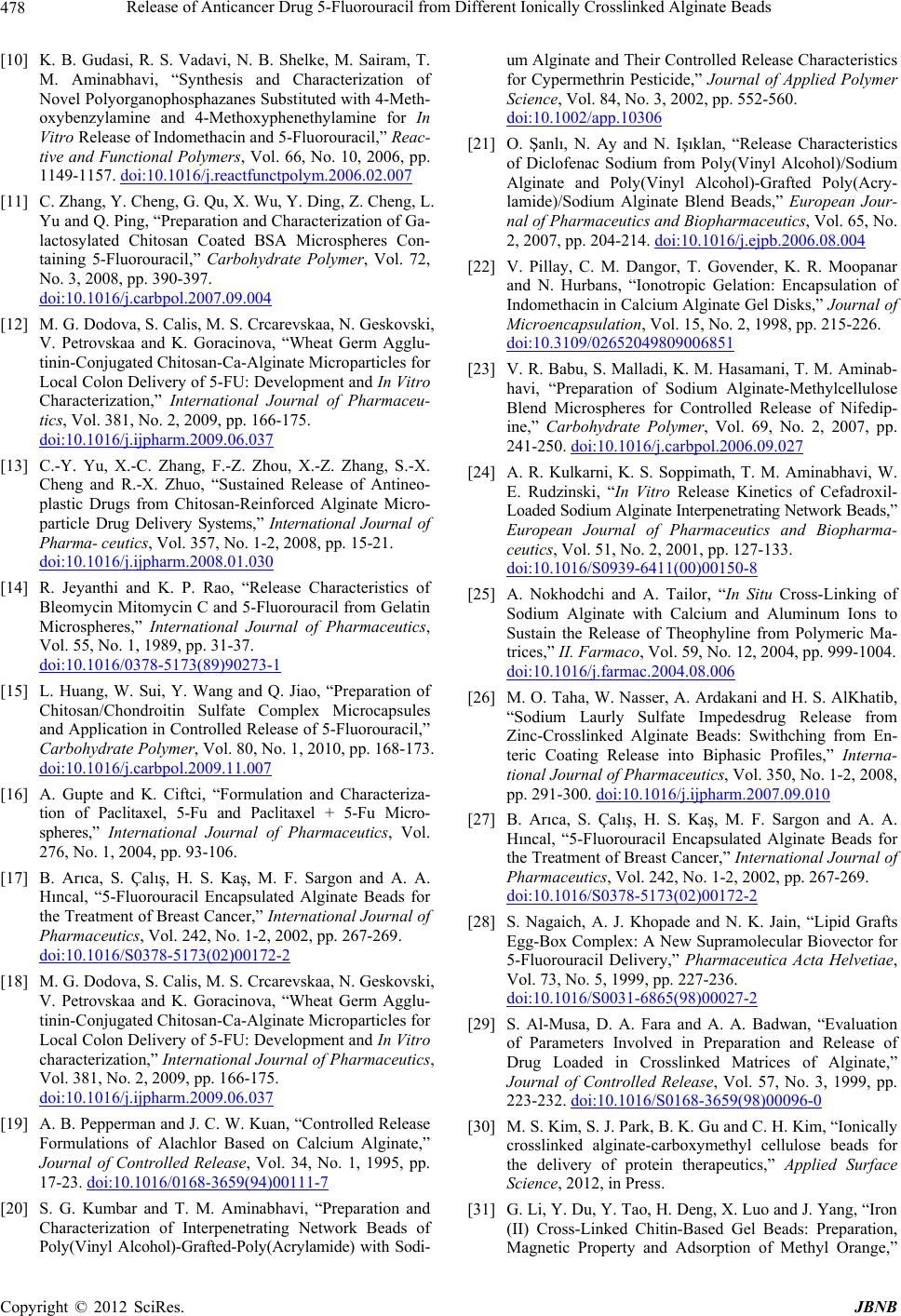
Release of Anticancer Drug 5-Fluorouracil from Different Ionically Crosslinked Alginate Beads
478
[10] K. B. Gudasi, R. S. Vadavi, N. B. Shelke, M. Sairam, T.
M. Aminabhavi, “Synthesis and Characterization of
Novel Polyorganophosphazanes Substituted with 4-Meth-
oxybenzylamine and 4-Methoxyphenethylamine for In
Vitro Release of Indomethacin and 5-Fluorouracil,” Reac-
tive and Functional Polymers, Vol. 66, No. 10, 2006, pp.
1149-1157. doi:10.1016/j.reactfunctpolym.2006.02.007
[11] C. Zhang, Y. Cheng, G. Qu, X. Wu, Y. Ding, Z. Cheng, L.
Yu and Q. Ping, “Preparation and Characterization of Ga-
lactosylated Chitosan Coated BSA Microspheres Con-
taining 5-Fluorouracil,” Carbohydrate Polymer, Vol. 72,
No. 3, 2008, pp. 390-397.
doi:10.1016/j.carbpol.2007.09.004
[12] M. G. Dodova, S. Calis, M. S. Crcarevskaa, N. Geskovski,
V. Petrovskaa and K. Goracinova, “Wheat Germ Agglu-
tinin-Conjugated Chitosan-Ca-Alginate Microparticles for
Local Colon Delivery of 5-FU: Development and In Vitro
Characterization,” International Journal of Pharmaceu-
tics, Vol. 381, No. 2, 2009, pp. 166-175.
doi:10.1016/j.ijpharm.2009.06.037
[13] C.-Y. Yu, X.-C. Zhang, F.-Z. Zhou, X.-Z. Zhang, S.-X.
Cheng and R.-X. Zhuo, “Sustained Release of Antineo-
plastic Drugs from Chitosan-Reinforced Alginate Micro-
particle Drug Delivery Systems,” International Journal of
Pharma- ceutics, Vol. 357, No. 1-2, 2008, pp. 15-21.
doi:10.1016/j.ijpharm.2008.01.030
[14] R. Jeyanthi and K. P. Rao, “Release Characteristics of
Bleomycin Mitomycin C and 5-Fluorouracil from Gelatin
Microspheres,” International Journal of Pharmaceutics,
Vol. 55, No. 1, 1989, pp. 31-37.
doi:10.1016/0378-5173(89)90273-1
[15] L. Huang, W. Sui, Y. Wang and Q. Jiao, “Preparation of
Chitosan/Chondroitin Sulfate Complex Microcapsules
and Application in Controlled Release of 5-Fluorouracil,”
Carbohydrate Polymer, Vol. 80, No. 1, 2010, pp. 168-173.
doi:10.1016/j.carbpol.2009.11.007
[16] A. Gupte and K. Ciftci, “Formulation and Characteriza-
tion of Paclitaxel, 5-Fu and Paclitaxel + 5-Fu Micro-
spheres,” International Journal of Pharmaceutics, Vol.
276, No. 1, 2004, pp. 93-106.
[17] B. Arıca, S. Çalış, H. S. Kaş, M. F. Sargon and A. A.
Hıncal, “5-Fluorouracil Encapsulated Alginate Beads for
the Treatment of Breast Cancer,” International Journal of
Pharmaceutics, Vol. 242, No. 1-2, 2002, pp. 267-269.
doi:10.1016/S0378-5173(02)00172-2
[18] M. G. Dodova, S. Calis, M. S. Crcarevskaa, N. Geskovski,
V. Petrovskaa and K. Goracinova, “Wheat Germ Agglu-
tinin-Conjugated Chitosan-Ca-Alginate Microparticles for
Local Colon Delivery of 5-FU: Development and In Vitro
characterization,” International Journal of Pharmaceutics,
Vol. 381, No. 2, 2009, pp. 166-175.
doi:10.1016/j.ijpharm.2009.06.037
[19] A. B. Pepperman and J. C. W. Kuan, “Controlled Release
Formulations of Alachlor Based on Calcium Alginate,”
Journal of Controlled Release, Vol. 34, No. 1, 1995, pp.
17-23. doi:10.1016/0168-3659(94)00111-7
[20] S. G. Kumbar and T. M. Aminabhavi, “Preparation and
Characterization of Interpenetrating Network Beads of
Poly(Vinyl Alcohol)-Grafted-Poly(Acrylamide) with Sodi-
um Alginate and Their Controlled Release Characteristics
for Cypermethrin Pesticide,” Journal of Applied Polymer
Science, Vol. 84, No. 3, 2002, pp. 552-560.
doi:10.1002/app.10306
[21] O. Şanlı, N. Ay and N. Işıklan, “Release Characteristics
of Diclofenac Sodium from Poly(Vinyl Alcohol)/Sodium
Alginate and Poly(Vinyl Alcohol)-Grafted Poly(Acry-
lamide)/Sodium Alginate Blend Beads,” European Jour-
nal of Pharmaceutics and Biopharmaceutics, Vol. 65, No.
2, 2007, pp. 204-214. doi:10.1016/j.ejpb.2006.08.004
[22] V. Pillay, C. M. Dangor, T. Govender, K. R. Moopanar
and N. Hurbans, “Ionotropic Gelation: Encapsulation of
Indomethacin in Calcium Alginate Gel Disks,” Journal of
Microencapsulation, Vol. 15, No. 2, 1998, pp. 215-226.
doi:10.3109/02652049809006851
[23] V. R. Babu, S. Malladi, K. M. Hasamani, T. M. Aminab-
havi, “Preparation of Sodium Alginate-Methylcellulose
Blend Microspheres for Controlled Release of Nifedip-
ine,” Carbohydrate Polymer, Vol. 69, No. 2, 2007, pp.
241-250. doi:10.1016/j.carbpol.2006.09.027
[24] A. R. Kulkarni, K. S. Soppimath, T. M. Aminabhavi, W.
E. Rudzinski, “In Vitro Release Kinetics of Cefadroxil-
Loaded Sodium Alginate Interpenetrating Network Beads,”
European Journal of Pharmaceutics and Biopharma-
ceutics, Vol. 51, No. 2, 2001, pp. 127-133.
doi:10.1016/S0939-6411(00)00150-8
[25] A. Nokhodchi and A. Tailor, “In Situ Cross-Linking of
Sodium Alginate with Calcium and Aluminum Ions to
Sustain the Release of Theophyline from Polymeric Ma-
trices,” II. Farmaco, Vol. 59, No. 12, 2004, pp. 999-1004.
doi:10.1016/j.farmac.2004.08.006
[26] M. O. Taha, W. Nasser, A. Ardakani and H. S. AlKhatib,
“Sodium Laurly Sulfate Impedesdrug Release from
Zinc-Crosslinked Alginate Beads: Swithching from En-
teric Coating Release into Biphasic Profiles,” Interna-
tional Journal of Pharmaceutics, Vol. 350, No. 1-2, 2008,
pp. 291-300. doi:10.1016/j.ijpharm.2007.09.010
[27] B. Arıca, S. Çalış, H. S. Kaş, M. F. Sargon and A. A.
Hıncal, “5-Fluorouracil Encapsulated Alginate Beads for
the Treatment of Breast Cancer,” International Journal of
Pharmaceutics, Vol. 242, No. 1-2, 2002, pp. 267-269.
doi:10.1016/S0378-5173(02)00172-2
[28] S. Nagaich, A. J. Khopade and N. K. Jain, “Lipid Grafts
Egg-Box Complex: A New Supramolecular Biovector for
5-Fluorouracil Delivery,” Pharmaceutica Acta Helvetiae,
Vol. 73, No. 5, 1999, pp. 227-236.
doi:10.1016/S0031-6865(98)00027-2
[29] S. Al-Musa, D. A. Fara and A. A. Badwan, “Evaluation
of Parameters Involved in Preparation and Release of
Drug Loaded in Crosslinked Matrices of Alginate,”
Journal of Controlled Release, Vol. 57, No. 3, 1999, pp.
223-232. doi:10.1016/S0168-3659(98)00096-0
[30] M. S. Kim, S. J. Park, B. K. Gu and C. H. Kim, “Ionically
crosslinked alginate-carboxymethyl cellulose beads for
the delivery of protein therapeutics,” Applied Surface
Science, 2012, in Press.
[31] G. Li, Y. Du, Y. Tao, H. Deng, X. Luo and J. Yang, “Iron
(II) Cross-Linked Chitin-Based Gel Beads: Preparation,
Magnetic Property and Adsorption of Methyl Orange,”
Copyright © 2012 SciRes. JBNB